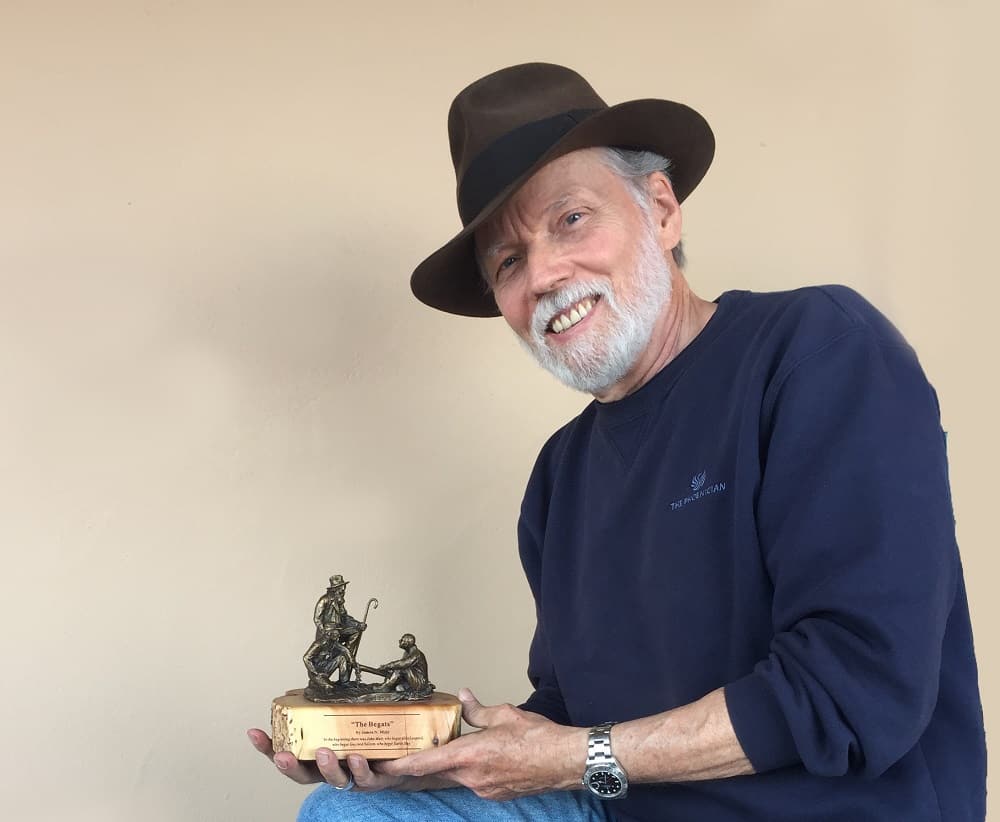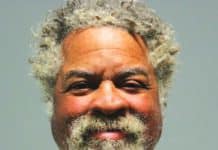
Allegorical sculptor James Muir has spent his lifetime translating his deep spiritual convictions and social consciousness into works of art reflecting the critical nature of the times in which we live. His work, prized by public and private collectors across the globe, speaks eloquently of duty, honor, courage and justice, but above all, truth and the ultimate triumph of the human spirit. His pieces are in both public and private collections internationally, including the George W. Bush Presidential Library in Texas.
Allegorical art is a term Muir uses to describe his art as being filled with symbolic meaning.
“To bring light into the darkness, such is the duty of the artist,” Muir said. “The longest journey is the journey within.”
Muir said he believes we are all given a path of service to humanity and considers his talents as his own way for him to contribute in a meaningful way. In keeping with his profound connection to the world around him, he has sculpted “The Begats,” capturing the three forces of nature, John Muir, Aldo Leopold and Wisconsin Senator Gaylord Nelson.
“My interest in doing the sculpture, The Begats, was to honor the legacy of three great founders instrumental in creating the ecology movement in America,” Muir said.
John Muir, to whom James Muir is related on branches of the family tree, is revered as America’s most famous and influential naturalist and conservationist. In 1892, he helped form the Sierra Club for which he served as president until his death. His legacy lives on today through continued Sierra Club programs that have helped to establish a series of new national parks and a National Wilderness Preservation System.
Leopold was best known for his influential book, “A Sand County Almanac.” His original ideas about conserving natural resources and his “land ethics” helped take conservation to new heights as he eventually adopted Muir’s view “that all wildlife — even predators like wolves, bears, and snakes — had value.” He was a co-founder of The Wilderness Society.
Nelson is celebrated as the founder of Earth Day. Following his election to the Senate in 1962, when he discovered his state had no environmental political agenda in place, he worked to devise a way to bring urgent environmental issues to the forefront. April 22, 1970, the first Earth Day, marked the beginning of the modern environmental movement.
“The Begats” involves a Socratic-type discussion between John Muir, Aldo Leopold and Gaylord Nelson. Muir is standing above the others, in deference to his status as the founding father of ecological and conservation awareness. His ubiquitous walking stick, resembling a staff, reflects his being the good shepherd, leading humanity through nature’s wilderness. Leopold is kneeling by his side, as the student and has just planted a young sapling to replace the one nature has re-claimed.
Nelson is seated, cross-legged on the ground, right hand upon the fallen tree, to denote Earth Day, as well as his being the “offspring” of both Muir and Nelson. True to form, James Muir has captured the ecologically minded group in detailed depictions of attire typical of their working clothes including details such as the hat and binoculars representative of the time period.
“I have chosen not to seat them on a bench — too urban; nor on tree stumps — too reflective of commercial exploitation; nor even on a rock – too insensitive to the earth,” Muir said. “As depicted, they are standing, kneeling and sitting by a beaver-cut tree. This selected portrayal not only pays homage to the symbiotic relationship of all living things in nature, but also provides a central spot for the viewer to sit or stand and feel like an equal participant in the conversation.”
Muir’s work can been seen in public collections throughout the country; there are over 20 life-size/ monumental sculptures in Arizona alone and 150 nationally. Pieces include the Maricopa County Sheriff’s Memorial “They Serve Well” in downtown Phoenix; Scottsdale Healthcare Hospitals’ “Caduceus” at Shea and Osborn locations; “The Newsboy” in downtown Mesa; and “Quo Vadis” at All Saints Episcopal on Central Avenue.
Other Arizona locations with his life-size and monumental are Sedona, Prescott, Flagstaff and Greer. His pieces strive to capture the essence of our journey. He created the face of his life-sized “The Holy Grail,” currently placed in a public art exhibition at Sedona City Hall, as a shiny reflective surface so that when the viewer gazed at the stunning piece he or she would see themselves reflected back.
His Caduceus also soars gracefully across the City Hall Plaza and his heartfelt “Children,” which captures the impact of war of children, is placed next to Sedona’s Peace Pole.
A life-size “Special Presentation” of “Children” is now in the permanent collection of the Auschwitz — Birkenau Holocaust Museum in Poland.
The newly finished monumental Christ of the Holy Cross, which was commissioned by the Archdioceses of Phoenix in honor of the renowned landmark’s 60th anniversary, will stand over 30 feet tall. Each element included in this sacred piece holds a special spiritual symbolism celebrating the Christ, his life and work. The Christ of the Holy Cross will be installed in the spring of 2018.
Muir is represented by Goldenstein Gallery in Sedona; for information, visit GoldensteinArt. com or 204-1765. Goldenstein Gallery is located at 150 SR 179, at the corner of State Routes 179 and 89A, and is open daily.


















